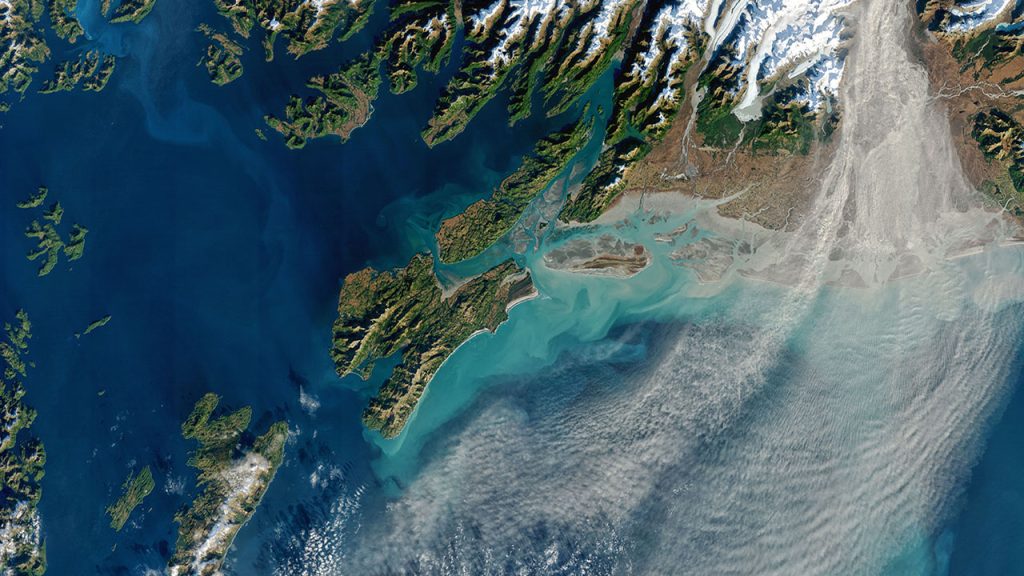
Southern Alaska acts as a source of climate-important dust
Large-scale dust storms in Southern Alaska have a bigger than expected impact on the global climate system, by sending tonnes of fine vegetation-rich silt into the atmosphere.
The giant dust storms, which can last for many days, could be having more influence on the earth’s climate than previously thought – suggests new research from the University of Leeds and the National Centre for Atmospheric Science (NCAS).
Dust particles in the atmosphere are important agents in ice formation. Without dust, water in clouds can remain in liquid form even though temperatures may be well below freezing.
Dust composed of fine sediment and silt – microscopic fragments of rock, minerals and vegetation – can encourage the formation of ice crystals in clouds.
Whether ice formation in clouds will contribute to global warming or help cool the planet depends on how much ice they contain, how many ice nucleating particles are present and the nature of those particles.
Only a small fraction of the dust particles in the atmosphere has the capacity to nucleate ice and we are only just starting to understand their sources and global distribution. Whether a cloud becomes more or less reflective of sunlight depends on how much ice is in them, so we need to be able to understand and quantify the various sources of ice-nucleating particles around the globe. At present, climate models tend not to represent these high-latitude sources of dust, but our work indicates that we need to.
Professor Ben Murray, an atmospheric scientist at the University of Leeds who is part of the research team.
In a paper published this week in the journal Science Advances, the research team explains why more research is needed to understand the influence dust has on our planet’s climate.
Previous research has focused on dust particles whipped up into the atmosphere from across Africa and Asia, all of which are at mid to low latitudes and involve dust generated from desert environments.
The researchers at Leeds and NCAS took a different approach and decided to focus on sources of high-latitude dust. They analysed dust coming from the Copper River, which extends for more than 275 miles before draining into the Gulf of Alaska. The river is estimated to transport 70 million tonnes of glacial sediment every year.
During periods of low water – in the summer and autumn – the silt from the Copper River is picked up by winds and carried over hundreds of miles across North America, reaching altitudes where it can cause ice formation in clouds.
Sarah Barr, a doctoral researcher at the National Centre for Atmospheric Science and University of Leeds, collected samples during dust storms in the Copper River area. The material was analysed in the laboratory and compared to the types of dust particles that originate from desert environments.
Unlike the dust from the Sahara, dust particles from the Copper Valley River in Alaska were found to contain a greater volume of biological material, deposited by the rich vegetation and wildlife that live in the region.
The particles from Alaska are more effective in forming ice, than the dust that comes from the Sahara, due to the greater presence of microscopic fragments of biogenic substances.
Sarah Barr, the lead author of the paper, said: “We knew that deserts like the Sahara are very important at supplying ice-nucleating particles to the atmosphere, but this paper shows that river deltas like the Copper River Valley are also very important. Huge quantities of dust are emitted from places like the Copper River, and we need to understand these emissions to improve our climate models.”
Dr Ryan Neely III, a senior observational atmospheric scientist at the National Centre for Atmospheric Science and University of Leeds, explains the importance of this research: “This work sets the bar for how we should be exploring the poles for sources of ice-nucleating particles and assessing their potential impact on the climate system.”
The paper, Southern Alaska as a source of atmospheric mineral dust and ice-nucleating particles, is published in Science Advances and can be downloaded from the Science Advances website.
The image was taken by a Landsat satellite and shows dust billowing out of the Copper River Valley – on the right hand side of the image – and extending out over the coast and into the atmosphere. Credit USGS/NASA Landsat.
